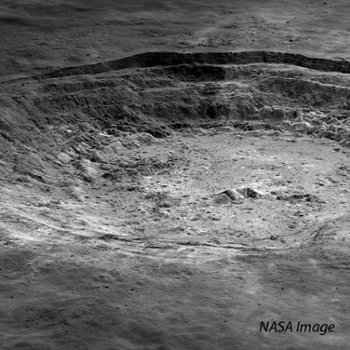EAPS Study Identifies Source of ‘Crater Equilibrium’
04-08-2019
Writer(s): Logan Judy

After several years of study, one thing is clear about the lunar surface: it is a very dynamic environment that changes over time. One example of this can be seen in the way that small craters degrade at the same rate as they form, keeping the number of small craters on the lunar surface constant over time. This equilibrium between the formation and degradation of craters also makes it difficult to judge the scale of close up images of the lunar surface. Despite decades of study, this equilibrium phenomenon has not been well-explained.
EAPS scientists have taken a crucial step in solving this problem in a publication authored by Dr. David Minton and coauthored by EAPS undergraduate student Bryan Howl. The paper, published in Icarus, uses mathematical models and computer simulation of the lunar surface to account for variables that can help make more sense of the lunar surface. According to Dr. Minton, The key finding from the study was the importance of ejecta, tiny pieces of the lunar surface that are thrown out during crater formation.
“The formation of each new crater degrades the old craters in a particular way, and we show that it is related to how the very numerous fragments of ejected material thrown at great distances by each and every new crater cause tiny amounts of degradation of all the craters that came before it,” Dr. Minton said. “The ejecta are very small by themselves, but collectively, they dominate the evolution of the lunar surface.”
These findings have implications for other areas of lunar research, as well. Dr. Minton anticipates their new model contributing to understanding the very earliest period of lunar history, when the bombardment rate was many times higher than it is in the present day. The findings may also shed light on the interpretation of lunar samples, a vital scientific endeavor that is, at times, surrounded by several unknowns.
“This is like one piece in a big puzzle. We try to understand this one problem, and then expand out to tackle more complicated problems,” Dr. Minton said. “One longstanding problem is that without knowing how this works, it’s hard to interpret the samples we bring back from the Moon. Astronauts pick up a piece of rock or soil or boulder off of the surface of the Moon, and we don’t really know the history of that sample, how many times it has been mixed and turned. By using this new information, we can begin to understand what those samples have experienced, as well as the Moon’s early history.”
Understanding the Moon’s early history can also aid in understand the early history of the Earth. Due to terrestrial environmental factors such as the atmosphere, plate tectonics, and other natural processes, elements of the planet’s early history is obscured. The absence of many of those elements on the Moon makes study of certain elements of the early solar system more attainable.
“The Moon is a witness plate to early solar system history,” Dr. Minton said. “By going to the Moon and studying the Moon, we get insight into what the Earth was like in its early days that we can’t get on the Earth itself.”
This research was supported by the NASA Lunar Data Analysis Program, and included collaborators from the NASA Marshall Space Flight Center, Auburn University, and the Planetary Science Institute. The article can be accessed online at the publication's website.